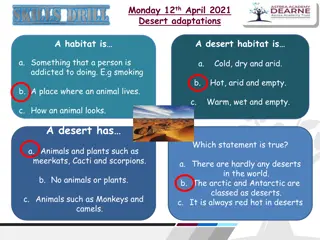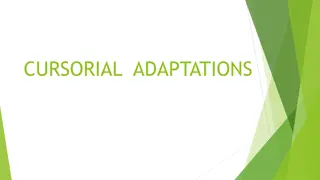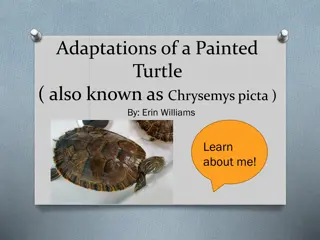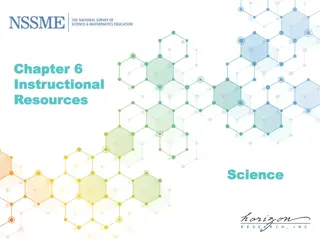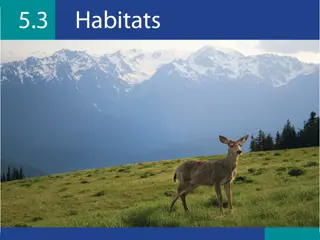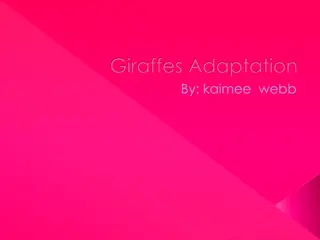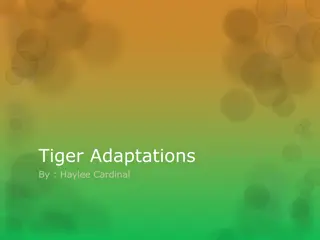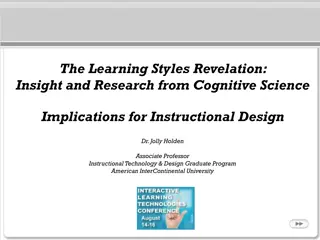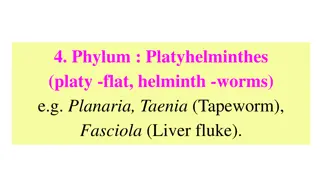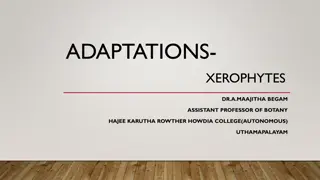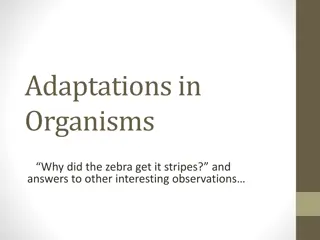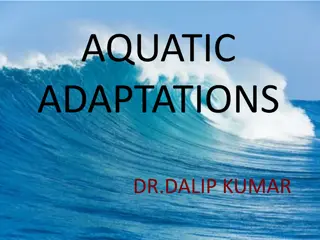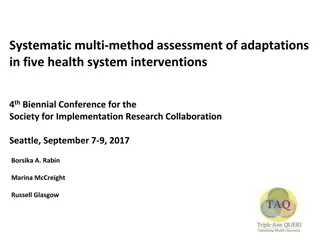Evolution of Film Adaptations: From Silent Cinema to Modern Innovations
The moving picture industry emerged in the 1890s, paving the way for adaptations of literary works in the early 1900s. With the advent of sound, a new era of adaptations began, leading to experiments and innovations in modern filmmaking. Adaptation is a process of adjusting and presenting a work in
8 views • 23 slides
Exploring Shared Instructional Leadership in Danish Schools
This study delves into how principals implement shared instructional leadership in Danish primary and lower secondary public schools, aiming to enhance dialogue on its potential in diverse cultural contexts. The Danish educational landscape, emphasizing autonomy and democratic participation, poses c
1 views • 14 slides
Academic Progress Monitoring for Effective Instructional Planning
Academic progress monitoring involves measuring student performance to evaluate responsiveness to interventions, guide instructional decisions, and determine when adjustments are necessary. It helps identify students needing additional support, compare instructional effectiveness, decide on changes,
2 views • 44 slides
Birds: Adaptations of Beaks and Feet for Survival
Explore the fascinating world of bird adaptations through the modification of beaks and feet. From tearing and piercing beaks to fruit-eating beaks, mud-probing beaks, fish-catching beaks, and wood chiselling beaks, discover how different bird species have evolved unique features to thrive in their
5 views • 29 slides
Exploring Seed Plant Diversity and Adaptations
Delve into the realm of seed plants, uncovering their unique adaptations for reproduction, their phylogeny with gymnosperms and angiosperms, and the diversity within gymnosperms such as conifers, cycads, gingkophytes, and gnetophytes. Discover the evolutionary success of seed plants through their wa
5 views • 23 slides
Understanding the Fascinating World of Fishes: A Comprehensive Overview
Fishes, the most numerous vertebrates on Earth, exhibit incredible diversity across various groups such as Agnatha, Chondrichthyes, and Osteichthyes. From jawless Agnatha like lampreys to bony Osteichthyes including lobe-finned and ray-finned species, fishes display unique characteristics and adapta
6 views • 8 slides
Behavior Progress Monitoring for Individualized Instructional Planning
Utilizing behavior progress monitoring allows educators to track student performance over time, make data-informed decisions to improve responsiveness to interventions, and tailor instructional plans for individual students. This comprehensive approach involves steps such as setting the stage, analy
6 views • 52 slides
Human Adaptations to Diverse Environments: A Study in Environmental Geography
Humans exhibit various biological and behavioral adaptations to thrive in different environments, showcasing our ability to modify and adapt to diverse ecosystems. This adaptation is essential for our survival in varied habitats, ranging from humid tropical forests to arctic wastelands. Through gene
5 views • 6 slides
Adaptations in Helminth Parasites: Structural and Morphological Changes
Helminth parasites exhibit adaptations for successful living within hosts, involving structural modifications such as degeneration and new organ formation. Parasitism has evolved over time, leading to a dependent relationship between parasites and hosts. The adaptations in locomotory, digestive, and
1 views • 19 slides
Desert Adaptations: Animals and Habitat Survival
Habitats play a crucial role in the survival of animals, especially in harsh environments like deserts. Explore the unique adaptations of animals like camels and learn how they are perfectly suited to thrive in hot, arid conditions. Understanding these adaptations is key to appreciating the diversit
0 views • 16 slides
Adaptations of Cursorial Animals: Cheetah, Horse, and Musk Deer
Explore the cursorial adaptations of three distinct animals - the cheetah with its incredible speed, the horse designed for swift running, and the musk deer adapted for elusive movements. Learn about their habitats, unique characteristics, and specialized adaptations for survival in their environmen
0 views • 12 slides
Jackson-Madison County School System Instructional Framework Overview
In the Jackson-Madison County School System, the focus is on a research-based instructional framework consisting of curriculum, lesson structures, and authentic literacy. Emphasizing the importance of a content-rich curriculum, effective teaching practices, and purposeful literacy, the district aims
0 views • 37 slides
Amazing Adaptations of the Painted Turtle
Discover the incredible adaptations of the painted turtle, also known as Chrysemys picta. Surviving freezing ponds, hibernating without oxygen, and using its colorful shell for camouflage are just a few ways this unique turtle thrives in its environment. Learn how it climbs with its clawed feet and
0 views • 8 slides
Science Instructional Resources Usage in Elementary and Middle School Classes
Explore the utilization of instructional resources in science classes across elementary and middle schools. The data showcases the distribution of various types of resources such as textbooks, kits/modules, online units, and more designated for educational purposes. Discover the percentage breakdown
0 views • 52 slides
Legislative Changes in School Calendar Policies
Significant legislative revisions were made to school calendar statutes in West Virginia during the 2013 legislative session, allowing more flexibility for county boards to develop calendars while ensuring a minimum of 180 instructional days. The changes mandated public hearings, set guidelines for
1 views • 63 slides
Amazing Adaptations of Lions in the Wild
Lions have incredible adaptations that aid in their survival and hunting strategies. Their loose body skin, mane, eyes, muscled forelimbs, rough tongue, color, and more play crucial roles in their ability to thrive in their environment. Explore these fascinating adaptations through images and descri
0 views • 8 slides
Understanding Habitats, Adaptations, and Food Chains in Ecosystems
Explore the concepts of habitats, adaptations, and food chains in ecosystems. Learn how different environments support diverse organisms, how adaptations aid survival, the impact of competition for resources, and the flow of matter and energy through food chains. Discover the interdependence of plan
0 views • 51 slides
Enhancing Instructional Leadership Through Classroom Walkthroughs
Effective instructional leadership in schools involves principals taking on roles as instructional leaders through classroom walkthroughs. These walkthroughs help assess teaching strategies, student engagement, and classroom practices, leading to improved learning outcomes. By focusing on key compon
0 views • 7 slides
Writing Effective Instructional Goals and Objectives in Education
Determine the importance of setting clear instructional goals and objectives for effective lesson planning in education. Explore the difference between goals and objectives, understand how to write instructional goals, and learn to create specific, measurable instructional objectives for student ach
0 views • 12 slides
Flexible Instructional Days (FID) Program Overview
The Flexible Instructional Days (FID) Program allows schools to provide remote instruction on days when traditional delivery is not feasible. Schools must apply to the Pennsylvania Department of Education (PDE) to participate in the program, which requires approval by the entity's governing body. FI
0 views • 25 slides
Evolution Unit Test Review - Adaptations and Benefits Matching
In this review, you will match various adaptations to the benefits they provide in the context of evolution. From heavy fur of the Snow Leopard to wing-like shape of maple seeds, explore how different adaptations help organisms cope with climate, obtain food and water, attract mates, escape predator
0 views • 21 slides
Enhancing Instructional Delivery Through Student Voices: A Study by Yelonda Harvey
Yelonda Harvey conducted a study at a Title I school in Ward 7 to investigate the impact of different instructional strategies on students' academic progress. The research involved administering questionnaires to fifth-grade science students, focusing on student preferences for various teaching moda
0 views • 16 slides
Effective Strategies for Online Course Development
Instructional Design for Online Courses by Michael W. Lindeman presents valuable insights into the systematic process of translating learning principles into instructional materials. It covers differences between face-to-face and online course planning, considerations for online course development,
0 views • 27 slides
Amazing Adaptations of Giraffes
Giraffes have unique adaptations that help them thrive in their environment. With their long necks, tough hooves, and specialized features like long tongues and tough lips, giraffes can reach high branches, protect themselves from harm, and access water efficiently. These adaptations, such as their
0 views • 10 slides
Overview of Instructional Services through LCAP
Explore how Instructional Services, including Elementary Education, Special Education, Child Development, Instructional Technology, Arts & Career Technical Education, and Induction programs, are structured and evaluated within the context of the Local Control Accountability Plan (LCAP). The organiza
0 views • 38 slides
Reconsidering the Matching of Texts to Students' Reading Levels
The prevailing belief that instructional materials should be tailored to students' reading levels to enhance learning may not be as effective as commonly thought. Contrary to this idea, evidence suggests that such text placements can hinder rather than facilitate student reading achievement. The his
0 views • 45 slides
Adaptations of Xerophytes in Different Habitats
Xerophytes, plants adapted to dry habitats, possess specific adaptations to prevent excessive water loss such as sunken stomata, presence of hairs, thick waxy cuticle, and rolled leaves. These adaptations help xerophytes thrive in arid conditions, maintaining humid air around stomata and maximizing
0 views • 13 slides
Effective Instructional Strategies for Engaging Students
Instructional tasks are modeled appropriately, explicit instruction is provided, and students are engaged in meaningful interactions. Opportunities for practice and corrective feedback are given, while encouraging student effort and success. Demonstrations and step-by-step guidance help students lea
0 views • 58 slides
Tiger Adaptations and Characteristics
Tigers possess unique adaptations such as their striped coat for camouflage, sensitive hearing capable of picking up infrasound, retinas that reflect more light, sharp claws for hunting and climbing, large teeth for catching prey, a long tail for balance while running, and a powerful roar when threa
0 views • 9 slides
Instructional Training for Public Health Professionals Module 4
This module focuses on enhancing instructional and delivery skills for public health professionals. Participants will learn to identify factors for effective delivery, recognize positive presentation skills, and describe tools used in instructional settings. Topics covered include instructor aptitud
0 views • 23 slides
Animal Adaptations in Different Habitats
Understanding animal adaptations in various habitats is crucial for appreciating how different species have evolved to thrive in specific environmental conditions. This presentation explores different habitats like woodlands, sand dunes, and rock pools, highlighting the unique features and adaptatio
0 views • 11 slides
Learning Styles and Instructional Design: Debunking Misconceptions
The concept of learning styles as predictors of learning outcomes is widely misunderstood. Research shows little impact on learning outcomes. This presentation explores the implications for instructional design and questions the relevance of considering learning styles as a variable in instructional
0 views • 56 slides
Jackson-Madison County School System Instructional Framework Overview
The Jackson-Madison County School System focuses on engagement through a research-based instructional framework centered on curriculum, lesson structures, and authentic literacy. Emphasizing the importance of a content-rich curriculum and effective teaching practices, the district aims to improve in
0 views • 26 slides
Comprehensive Analysis of Instructional Model and Engagement in a Lesson
This analysis examines the instructional models exhibited by a teacher during a lesson, focusing on engagement and strengths. Recommendations for potential improvements are also discussed. The content includes images and discussions on identifying instructional models, strengths of the lesson, and r
0 views • 6 slides
Understanding Platyhelminthes: Characteristics and Adaptations
Platyhelminthes, also known as flatworms, exhibit a dorsoventrally flattened body with bilateral symmetry. They can be endoparasites or free-living organisms, with some displaying unique adaptations for attachment and survival. These acoelomate organisms lack a complete digestive system, excreting w
0 views • 6 slides
Exploring Crayfish Anatomy and Adaptations in Biology Lab
Explore the fascinating world of crayfish anatomy and adaptations through hands-on dissection activities in a biology lab setting. Identify phylum, examine external anatomy, study compound eyes, and delve into the function-form relationship within the phylum. Engage in interactive tasks like drawing
0 views • 22 slides
Xerophytes: Adaptations to Thrive in Dry Environments
Xerophytes are plants that adapt to dry habitats by developing specialized structural and physiological features. These adaptations include deep root systems, succulent tissues for water storage, reduced leaf size with protective waxy coatings, and shortened life cycles for favorable conditions. Mor
0 views • 8 slides
Understanding Adaptations in Organisms: from Zebra Stripes to Diabetes
Adaptations in organisms play a crucial role in survival within their ecological niche. This article explores the reasons behind zebra stripes, the impact of traits that may not seem advantageous, the mechanisms of diabetes, and how environmental conditions can influence genetic traits. By delving i
0 views • 20 slides
Aquatic Adaptations in Marine Life
This informative content discusses the primary and secondary aquatic adaptations in marine animals such as fish, whales, turtles, and ducks. It covers various adaptations like streamlined bodies, presence of swim bladders, flippers for navigation, and webbed feet for swimming. Each adaptation is vit
1 views • 14 slides
Systematic Assessment of Adaptations in Health System Interventions
This presentation at the 4th Biennial Conference for the Society for Implementation Research Collaboration discusses the systematic multi-method assessment of adaptations in five health system interventions. It covers the definitions of adaptations, balancing fidelity and adaptation, and lessons lea
0 views • 23 slides









